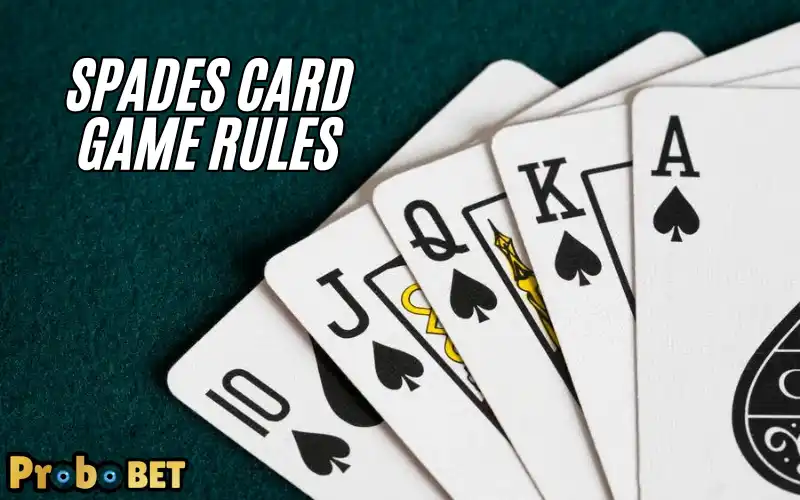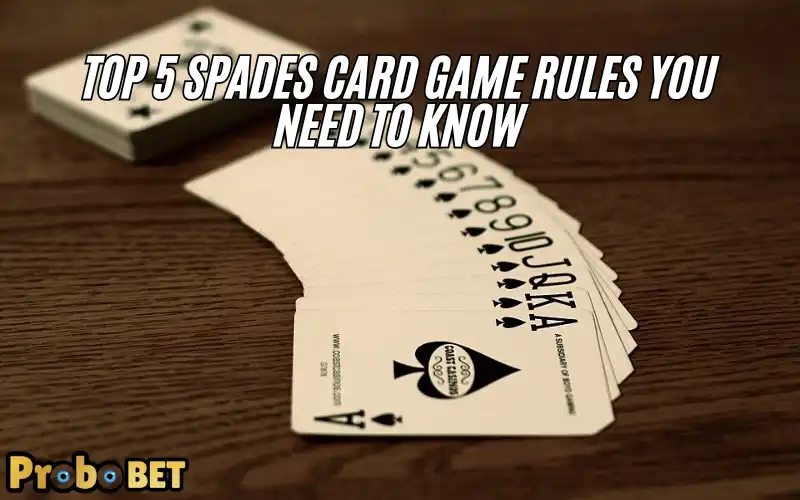Spades is a classic card game that has entertained players for generations. Known for its strategic depth and social interaction, Probobet Spades is a favorite among friends and family gatherings. Whether you’re a seasoned player or a newcomer, understanding the rules of Spades is essential for enjoying the game to its fullest. In this article, we will explore the top five Spades card game rules you need to know to play effectively and have fun.
1. Understanding the Basics of Spades
Before diving into the specific rules, it’s important to grasp the basic structure of the game. Spades is typically played with four players in two partnerships. The objective is to accurately predict the number of tricks your team can win in each round. A standard deck of 52 cards is used, and the game is played in a clockwise direction.
Key Components:
- Players: Four players divided into two teams.
- Deck: A standard 52-card deck without jokers.
- Tricks: A trick consists of one card played by each player, and the highest card wins the trick.
2. The Deal and Bidding Process
The first step in playing Spades is the deal, followed by the bidding process. Understanding how to deal cards and place bids is crucial for setting the stage for the game.
Dealing Cards:
- Each player is dealt 13 cards, one at a time, in a clockwise manner.
- Players should keep their cards hidden from opponents.
Bidding:
- After the cards are dealt, players assess their hands and make a bid on the number of tricks they believe their team can win.
- Bids can range from 0 (nil) to 13, and players must communicate their bids clearly.
- The total bids of both partners are combined to determine the team’s goal for the round.
Important Note:
- Players cannot change their bids once they have been made, so it’s essential to evaluate your hand carefully.
3. Playing the Game: How to Win Tricks
Once the bidding is complete, the game moves into the trick-taking phase. Understanding how to play cards and win tricks is fundamental to succeeding in Spades.
Playing Cards:
- The player to the dealer’s left starts the first trick by playing any card from their hand.
- Players must follow suit if they can. If a player cannot follow suit, they may play a Spade or any other card.
- Spades are always the trump suit, meaning they can win over any other suit unless another Spade is played.
Winning Tricks:
- The highest card of the suit led wins the trick unless a Spade is played.
- If a Spade is played, the highest Spade wins the trick.
- The winner of each trick leads the next trick.
Strategy Tip:
- Pay attention to the cards played and try to remember which high cards have been used. This can help you make strategic decisions in future tricks.
4. Scoring in Spades
Scoring is a critical aspect of Spades, as it determines the winner of the game. Understanding how to score correctly will help you keep track of your team’s progress throughout the game.

Basic Scoring Rules:
- Each team earns points based on the number of tricks they successfully win.
- If a team meets or exceeds their bid, they score 10 points for each trick bid.
- For every trick won beyond the bid, teams earn an additional point per trick.
Penalties:
- If a team fails to meet their bid, they lose 10 points for each trick they bid.
- Accumulating too many unsuccessful bids can lead to significant point deductions.
Nil Bids:
- A player may choose to bid nil, indicating they believe they will not win any tricks.
- If successful, the team earns a bonus of 100 points; if they fail, they lose 100 points.
Winning the Game:
- The game typically continues until a team reaches a predetermined score, often 500 points. However, players can agree on a different target score before starting.
5. Special Rules and Variations
Spades has several variations and special rules that can add excitement and complexity to the game. Familiarizing yourself with these variations can enhance your gameplay experience.
Common Variations:
- Jokers Wild: Some versions include jokers as wild cards, which can be played as any card.
- Blind Bidding: Players may opt for blind bids, where they bid without looking at their cards. This can lead to higher rewards but also greater risks.
- Partnership Communication: Some players allow limited communication between partners, such as signaling through card play, to strategize more effectively.
House Rules:
- Many groups have their own house rules, which can include variations in scoring, bidding, and gameplay. Always clarify the rules with your fellow players before starting a game.
Conclusion
Spades is a thrilling card game that combines strategy, teamwork, and a bit of luck. By understanding the top five rules outlined in this article—grasping the basics, mastering the deal and bidding process, learning how to win tricks, scoring effectively, and being aware of special rules—you’ll be well on your way to enjoying this classic game. Whether you’re playing casually with friends or in a more competitive setting, these rules will help you navigate the game with confidence. So gather your friends, shuffle the deck, and get ready for an exciting game of Spades!






















